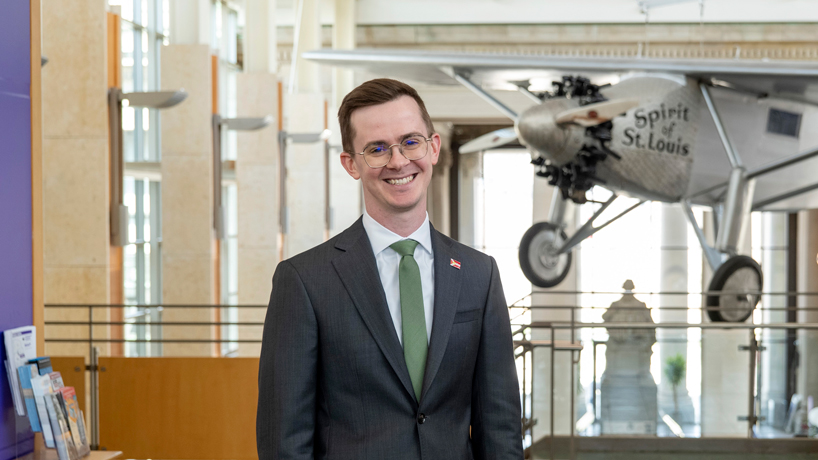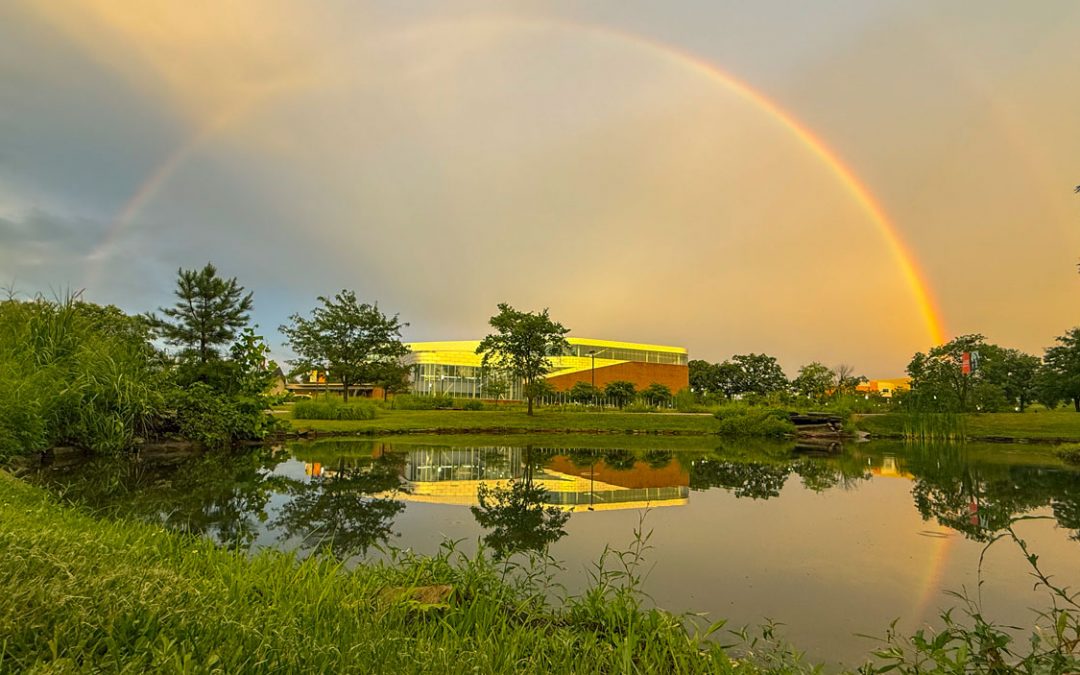
Sam Moore, a graduate of UMSL’s museum studies graduate program, returned to St. Louis to serve as managing director of public history at the Missouri Historical Society after leading several institutions in Pittsburgh. As managing director, he is excited to have a hand in some of the organization’s most important work, including visitor experience on the museum floor, exhibit programming and tourism efforts. (Photo by August Jennewein)
As a child, Sam Moore often journeyed with his family from Highland, Illinois, to Chicago for summer vacations. It was in the Windy City that museums first captivated him.
“When you go to Chicago, you go to museums – at least you did in my family – places like the Shedd Aquarium, the Museum of Science and Industry,” Moore said. “For me, one of the most formative museum experiences I’ve ever had was at the Field Museum. As a kid when you’re at the Field Museum, it’s this massive museum of everything, right? You’ve got dinosaurs; you’ve got mummies; you’ve got natural history dioramas; you’ve got Native American history.”
Those visits foreshadowed Moore’s now successful career in museums.
After double majoring in history and political science at Southern Illinois University Edwardsville, Moore earned a master’s degree in the University of Missouri–St. Louis’ esteemed Museums, Heritage, and Public History graduate program. From there, he taught as an adjunct instructor at UMSL; led several institutions in Pittsburgh, including serving as the founding executive director of the Moonshot Museum; and has now returned to St. Louis to act as managing director of public history at the Missouri Historical Society.
“It’s an honor to be back, quite frankly, in this role,” he said. “Certainly, my journey within the Missouri Historical Society starts with UMSL, and it starts with the incredible folks here. So, I’m excited to continue that now.”
A fork in the road
When Moore entered college, he wasn’t sure there was a career to be had in the museum field, and initially focused on political science. His experience interning at the Abraham Lincoln Presidential Library and Museum changed that.
Moore sought the internship because the museum is operated by the state of Illinois – not by a historical society or an independent nonprofit – and he thought he wanted to work in state government.
“That was an interesting coming together of history and state politics,” he said. “Once I got there and was working with visitors and spending time in the galleries, there was this ‘aha’ moment. I don’t want to work in politics. I don’t want to work in state government. I can work in places like this and do good work and do fulfilling work.”
The highly focused curriculum of UMSL’s museum studies graduate program in the History Department, as well as its emphasis on practical experience, drew Moore to the university. He noted that the program is built upon the principle of graduate research assistantships in museums.
“You are in a museum contributing to operations and contributing to the real-time work, introducing you to those organizations as real-world, complex workplaces,” he said.
Ironically, Moore accepted his first full-time museum job as the assistant director of the Campbell House Museum in downtown St. Louis at the same time he was accepted to the program, so he was not required to complete an assistantship. But the program was still instrumental during his early career.
“The UMSL museum studies program was incredibly beneficial to me,” he recalled. “It opened up a network of people to me that I would not have had otherwise. It opened up a network of people, even more importantly, in a museum city like St. Louis, which punches way, way above its weight. When you look at our population, when you look at just the general makeup of St. Louis, we have incredible museums here. We have world-class museums in this region.”
A key member of that network was Katie Van Allen, an adjunct instructor and graduate of the program herself, who would later become Moore’s colleague at the Missouri Historical Society, where she serves as the managing director of collections and chief of staff. After graduating with his master’s degree, Moore felt compelled to guide future students as professionals like Van Allen had guided him.
From 2016 to 2018, Moore taught two museum studies practicum courses at UMSL. One focused on public engagement, where Moore’s students worked with the Sappington House Museum in Crestwood, Missouri, to improve visitor experience. The other course concerned the exhibit design of “Flores Mexicanas: A Lindbergh Love Story” at the Missouri History Museum.
The exhibit featured the titular “Flores Mexicanas” painting by Alfredo Ramos Martínez, a wedding gift to Charles and Anne Lindbergh from Mexican President Emilio Portes Gil in 1929. Students created a 93-page concept packet that included design work, content writing and public program planning.
“What I loved about teaching for UMSL is that I got to focus my courses on museums, again as real-world, complex workplaces, where we’re bringing theory to bear alongside the practicalities of work,” Moore said. “Because nothing is ever quite as clean as the textbook makes it out to be, and this was an opportunity for students to really experience that.”
Around the same time, Moore moved from the Campbell House to the Missouri Historical Society to serve as the digital communications manager. The organization is housed in the Missouri History Museum, and in the new role, Moore built the framework for the museum’s digital and traditional marketing. He also served on a leadership team that rebranded the entities under the purview of the MHS: the museum, the Missouri Historical Society Library and Research Center and the Soldiers Memorial Military Museum.
Steel City detour
In 2018, Moore accepted a position as the director of public programs at the Senator John Heinz History Center in Pittsburgh, overseeing programming and public events covering the breadth of western Pennsylvania’s history from the steel industry to “Mister Rogers’ Neighborhood.”
He took on a new challenge in 2021, building the Moonshot Museum from the ground up as founding executive director. The museum, which is the first of its kind, focuses on career readiness for the 21st century space industry and the future of space exploration. To do so, the museum partnered with Astrobotic Technology, a leading space robotics company that specializes in building lunar landers.
Early on, Moore wore many hats, joking that he was CFO and director of IT and HR. In about 18 months, he was able to recruit a team, complete exhibit design and installation, build a public programming portfolio and lead a $3 million fundraising campaign.
Launching a museum in that time is no easy feat, but the hard work was worth it when doors opened in October. Visitors are able to view the cleanroom where Astrobotic is building a Peregrine Lunar Lander. In May, the company is slated to launch the Peregrine, making it the first commercial spacecraft to land on the lunar surface.
“It was an experience unlike anything I’ve ever had, or expect to have again, in my life and my career,” Moore said. “Being the founding executive director of Moonshot Museum is the hardest and most fulfilling job I’ve ever had, truly.”
Meet me (back) in St. Louis
Moore had no intention of leaving the Moonshot Museum – he and his husband had come to love Pittsburgh – but he couldn’t pass up the opportunity to work with the MHS and return to St. Louis. As managing director, he is excited to have a hand in some of the organization’s most important work, including visitor experience on the museum floor, exhibit programming and tourism efforts.
“It’s an especially exciting moment because we’re on the edge of five years of transition and transformation,” he said. “We’re going to launch new feature exhibit galleries, tackling topics ranging from the fullness of St. Louis history to the 1904 World’s Fair.
“We’re going to share stories that haven’t been shared before, and really position ourselves more and more as the place where St. Louis has big conversations about both its past and its future because those things are so indelibly linked.”
One such story is St. Louis’ importance as a soccer hotbed in the upcoming “Soccer City” exhibit.
“We’ve got 150 years of soccer history here in St. Louis, and there have been men and women contributing to fueling the world’s most popular sport for years and years,” Moore said. “We’re going to tell that story on April 8. It’s a perfect year to open a soccer exhibit. It’s the perfect year to bring St. Louis in and celebrate the success of everything that’s happening downtown right now with the MLS team and tell some stories to give that some context.”
Moore is also proud to feature the city’s LGBTQ history.
“We have an incredible exhibit coming up focused on LGBTQIA+ history in St. Louis – a rich, rich history here in the city,” Moore said. “As a queer man, that certainly is something that I feel personally about, and I’m excited to learn more about my city – all of the stories that really haven’t ever been told that we’re going to be sharing here.”
He, and many others across the country, are in a position to bring those untold stories to light because of the museum studies program at UMSL.
“UMSL is a powerhouse in its own right when it comes to being a really strong public university in Missouri, but the museum studies program, you will be hard-pressed to find a major museum or museum city that does not have an UMSL graduate working somewhere in a really critical role,” Moore said. “This program, for 20 some odd years, has been producing really talented, really diverse and really skilled graduates.”














